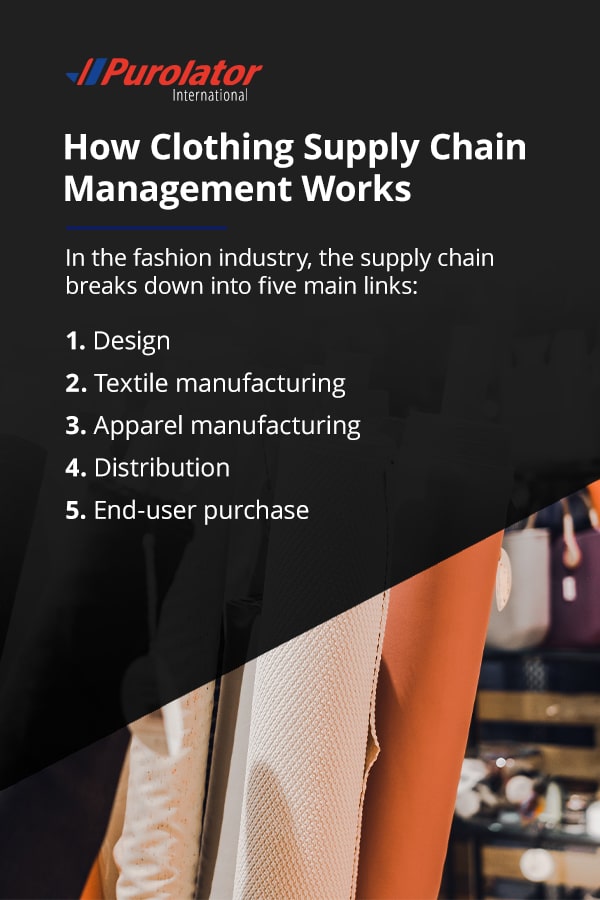Blog
What You Need to Know About Fashion and Apparel Supply Chain Management

In a competitive, fast-paced industry like apparel, supply chain management is critical. It’s the driving force behind a successful fashion season and a brand’s ability to pivot to the latest styles quickly. A strong supply chain strategy in fashion requires some special considerations because the industry has such short product lifecycles and high consumer demands.
Here’s what you need to know about apparel & fashion supply chain management.
- Why Advanced Supply Chain Management Is Crucial in the Fashion Industry
- How Clothing Supply Chain Management Works
- Benefits of Proper Supply Chain Management in the Apparel Industry
- What to Consider Before Implementing Advanced Supply Chain Management Strategies
- Best Practices for Apparel Supply Chain Management
Why Advanced Supply Chain Management Is Crucial in the Fashion Industry
Advanced supply chain management (SCM) benefits practically every industry. In apparel, where fast fashion, ever-shifting trends and micro-seasons numbering in the double digits impact the entire industry, it’s absolutely critical. Fashion retailers must carry a wide variety of products to fit many customers’ preferences. And the lightning-fast pace at which items come in and out of vogue means the industry’s product lifecycle is incredibly short. The fashion industry is constantly planning for the next season, getting new styles into production and perfecting them before the current pieces fall out of favor.
The industry also has a more complex supply chain. It includes the manufacturers creating the fibers, textiles and finished garments, which adds three links to the chain before involving wholesalers and retailers. The supply chain starts with new designs, which are then produced, distributed and sold. This added complexity requires an organized, knowledgeable logistics leader to drive new products through the supply chain and manage inventory flow throughout.
Meanwhile, consumers now demand more transparency in the supply chain. Due to labor abuses overseas, many customers look at where their clothes are produced and under what conditions. Clothing brands may work with many manufacturers to create so many unique styles in such a short time. The typical fashion brand reports between 1,000 and 2,000 suppliers, with numbers reaching 20,000 to 50,000 when including sub-suppliers.With the increased demand for 100% supply chain visibility, these companies must find a way to monitor and manage their complex supplier networks.
Demand forecasting is also challenging in the fashion industry. Since fashion trends come and go so quickly, every product at the start of the season has no sales history. Therefore, retailers can’t look at the past year’s sales numbers to determine how a product will perform. The product lifecycle is short, which means your business needs to be preparing for the next season and looking for the next big thing before their current stock goes out of style.
Meanwhile, consumer preferences are constantly in flux. Last year’s hottest trend may soon look stale and out of touch, or it could just as easily continue to rise in popularity. Trends arise out of the media, individual influencers, the economy and even the weather. For example, a rainy spring might boost outerwear sales while putting a damper on other spring arrivals.
Apparel companies need to prevent shortages and overstocked goods, which is especially important with shorter fashion seasons. Running out of an item at the wrong time can severely impact the season’s sales. Having too much leftover as new styles come into season reduces your profitability and wastes space in the retail storefront or warehouse. Effective supply chain management ensures a steady supply of product, arriving just in time to meet current demands.
Without an advanced, competent SCM structure, apparel brands and retailers struggle to meet consumer needs. Their inventory costs increase while product quality and suitability for the target customer decrease.
How Clothing Supply Chain Management Works
The apparel supply chain includes a broad network of clothing designers, fabric and finished apparel producers, transportation providers, wholesalers and direct-to-consumer retailers. It connects all the organizations involved in turning raw materials into finished garments and distributing them to customers. In the fashion industry, the supply chain breaks down into five main links:
- Design: In the first step, fashion designers choose fabrics, trims, fits and finishes for clothing items and carefully plan each silhouette. They often create their own iteration of the latest trend or may create the runway looks that others want to replicate. Designers are often the ones directing the rest of their supply chain. For example, they approve the fabrics and materials manufacturers use, alongside the sellers that carry their products.
- Textile manufacturing: Each garment requires raw materials. Textile producers spin, weave, blend and dye cloth and create other materials for the final product.
- Apparel manufacturing: Next, garment makers cut the cloth and sew it into wearable pieces, following the patterns and designer specifications.
- Distribution: Distribution in the fashion industry is complex since raw materials and finished apparel are produced worldwide and imported into key markets. Items may be shipped directly to retailers or to a distribution center that may feed multiple retailers. A well-managed supply chain includes detailed tracking, allowing brands to manage and optimize transportation and know exactly where shipments are along their routes.
- End-user purchase: At the end of the supply chain, a customer purchases the item. They may buy it from a brick-and-mortar retailer, shop online or choose a “buy online pick up in-store” (BOPUS) option. For online retailers, this portion of the supply chain places greater importance on logistics and transportation management. Brick-and-mortar retailers must emphasize good sales floor and storeroom management to please in-person and BOPUS shoppers. All retailers must focus on inventory management to ensure they can sell to consumers however they prefer to shop.
Fashion brands often use one of three strategies to manage their supply chain:
Push Supply Chain
A push supply chain strategy uses market forecasting and predictions to drive the supply chain. Producers and designers create clothing pieces in anticipation of upcoming demand. They then “push” these products to end-consumer retailers. In fashion, warm weather wear appears on shelves at the end of the cold season in preparation for the increased demand as the weather heats up.
Pull Supply Chain
The pull strategy waits for demand to rise rather than forecasting it. Manufacturers produce new items only when they know consumers will buy them. In other words, end-users and consumer-facing retailers pull apparel through the supply chain. This reduces the risk of inventory becoming overstocked while increasing the risk of not meeting a sudden influx in demand.
Hybrid Push/Pull Supply Chain
Fashion brands can combine both supply chain strategies using the push/pull method. This helps brands save on inventory costs while reducing the risks of unpredictable demand, which is so common in the fashion industry. Under this configuration, the supply chain starts as a push system, where textile producers constantly create fabrics in anticipation of new garment designs. The demand for new fashion pieces pulls these materials into garment production plants and the rest of the supply chain to end consumers.
Other brands may push finished garments to a warehouse, where they wait to be pulled into the retail environment when the demand arises.
Benefits of Proper Supply Chain Management in the Apparel Industry
Supply chain management increases productivity and improves organizational cohesiveness. It offers benefits such as:
1. Operational and Organizational Flexibility
Staying competitive in the fast-fashion market requires an incredible amount of precision and flexibility. Clothing brands that want to remain trendy need to work with designers and manufacturers to change their operations for a new product line. Managing a diverse supplier network and staying in close contact with key suppliers across that network helps companies do this more effectively. They can quickly identify the right designers and manufacturing partners to take on particular projects, and those team members can adapt just as quickly. This flexibility leads to a more cohesive organization overall.
2. Minimized Inventory Costs
Fashion retailers who work well with a diverse supplier network can minimize costs in many ways. First, they can get samples and quotes from several suppliers before committing to new orders. Next, by effectively forecasting needs, retailers can order less safety stock. They can place new orders based on current demand, giving them more confidence that they can sell the inventory they’re buying. This strategy lets retailers keep enough stock to meet customer demands without overstock to clear out at the end of the season.
3. Better Resource Management
Transparency, sustainability and ethical supply chains are becoming more critical to consumers. Better SCM leads to better resource management. Logistics chain leaders can analyze the raw materials that go into their products and work directly with suppliers to adopt more sustainable practices. This has tremendous business impacts since less material goes to waste, and manufacturers can reduce their energy and water consumption.
4. Increased Productivity and Better Logistics Management
Better communication and collaboration with all tiers of suppliers help clothing brands continue producing goods in all circumstances. They’re less likely to face disruptions related to supplier delays and wider raw materials shortages. They can quickly find out about potential concerns long before they affect the market. By diversifying their supplier networks, they can more easily pivot to different suppliers amid logistical hiccups.
What to Consider Before Implementing Advanced Supply Chain Management Strategies
There are a few things to know about fashion supply chain management before you enact a new system for your company. Key considerations for implementing an effective SCM system include:
1. Involving Key Stakeholders
Involving key stakeholders early makes change management easier. For supply chains, it’s imperative to include the workers whose workflows will change the most. That might encompass your sourcing managers, suppliers and transportation and logistics providers. Their involvement ensures a smoother transition and will help you find the holes in proposed changes. With their aid, the new SCM functions and processes will be more readily accepted and become more refined.
2. Planning for Long-Term Success
Implementing effective SCM is a process. As a manager, you must carefully consider the scope, schedule and necessary resources required for successful execution. While apparel organizations face pressure to achieve a fast return on investment, trying to implement too much too quickly can endanger your project. Creating a phased, long-term plan to roll out a new logistics and supplier management system can help you avoid risks and smooth out your processes along the way.
3. Gaining Supplier Buy-In
A managed supply chain will place new demands on suppliers. You may require them to hold specific certifications or follow new practices. Your new system will necessarily impact suppliers, so make sure they can meet your new expectations. If you’re a big-name clothing brand, you’ll likely have an easier time convincing suppliers to adopt your system.
If you’re a smaller or mid-sized brand, you’ll need to ensure you minimize burdens for your suppliers. It must be easy to use and add value for your partners. Besides focusing on the system itself, you’ll also need to finesse how you present your requests to vendors.
Best Practices for Apparel Supply Chain Management
While implementing a new system can be challenging, once you know how to manage supply chain operations in the apparel industry, you can achieve higher productivity, better profits and a more cohesive, effective company overall. Here are a few best practices to keep in mind:
1. Align Priorities and Plans Across Teams and Suppliers
Many fashion brands manage several product lines and sales channels. With large companies divided into many departments, it’s common for individual teams to plan around their own priorities, leaving the supply network disjointed. A business should have a global supply chain plan aligned across stakeholders and departments. All teams should have the same logistical goals and work from one united program.
2. Prioritize In-Season Sales
When items are in season, they sell for the highest price. Ensuring that all your in-season inventory performs well is crucial. By letting yourself sell out of your styles before the end of the season, you avoid placing items on clearance. This increases the urgency for your products since shoppers can’t be sure that a product will be marked down in a few weeks.
To optimize in-season sales, many fast-fashion retailers start by producing a limited quantity of a new style. They then ramp up production for styles that sell quickly and do not reorder the slower-moving products. This “test and repeat” strategy helps them make the most out of a fashion season and sell off stock before it moves to markdowns.
3. Segment Customers for a More Efficient Supply Chain
If you’re an apparel retailer with a wide product selection, each product may appeal best to a particular type of customer. It’s essential to segment your finished goods and how you market them to your customers. Effective supply chain managers also use these customer segments to enhance the supply chain. They may work with specialized designers, manufacturers and logistics companies to manage products for varying markets.
4. Focus on Total Cost of Ownership (TCO) Over Price
The initial acquisition costs of inventory in the apparel supply chain can be deceptive. In the apparel industry, moving manufacturing offshore sometimes offers reduced labor costs and other benefits. However, fashion brands may pay for that cost in shipping and more complex transportation logistics. This can reduce the cost of manufacturing while increasing the TCO. Inventory also requires storage, which is sometimes a hidden cost. Effective supply chain managers prioritize each product’s TCO.
Keeping the TCO down may require paying more for a product initially. For example, if you order more frequently in smaller quantities, you may not get the same volume discounts. However, the savings that come with renting a smaller warehouse, with less risk of inventory going out-of-season, often make up for it.
The Best Time to Implement Fashion Supply Chain Management
As fashion retailers grow, their supplier network becomes more complex and interconnected. When you have many vendors, it’s useful to standardize your supplier expectations and management practices. More complex supply chains that require more time to get products from raw materials to end consumers need more management. As you decide whether it’s the right time to implement a new SCM system, consider your current level of vendor complexity and your plans for the future.
Do you currently manage several tiers of suppliers or plan to monitor your raw material suppliers more closely? Are you diversifying your supplier network to become more resilient to logistical bottlenecks? If you have many suppliers or plans to add more soon, a better management system may be in order.
Trust Purolator International for Apparel Industry Shipping Logistics
An impressive 49% of retailers say shipping products through the supply chain can take 30 days or more out of the total 4.5 months it takes to get new designs to market. Purolator International can help you change that. We are your go-to experts for getting your products quickly over the border from the United States to Canada. We serve the apparel industry with many shipping solutions. Whether you’re shipping to a Canada-based warehouse, retailer or end-consumer, we can get your latest collection there on your desired timeline.
The apparel industry faces increased demands for shorter shipping times, and we can accommodate fast, direct-to-consumer shipments with our PuroPost e-commerce shipping services. We also offer route optimization, definite day-of delivery windows and day-definite deliveries through Purolator Express and Expedited Forwarding services. The apparel industry also needs fast and effective returns management, which is why we offer integrated reverse logistics that improve your customer relationships.
To learn more about custom logistics solutions to streamline your apparel supply chain, contact Purolator International today.



